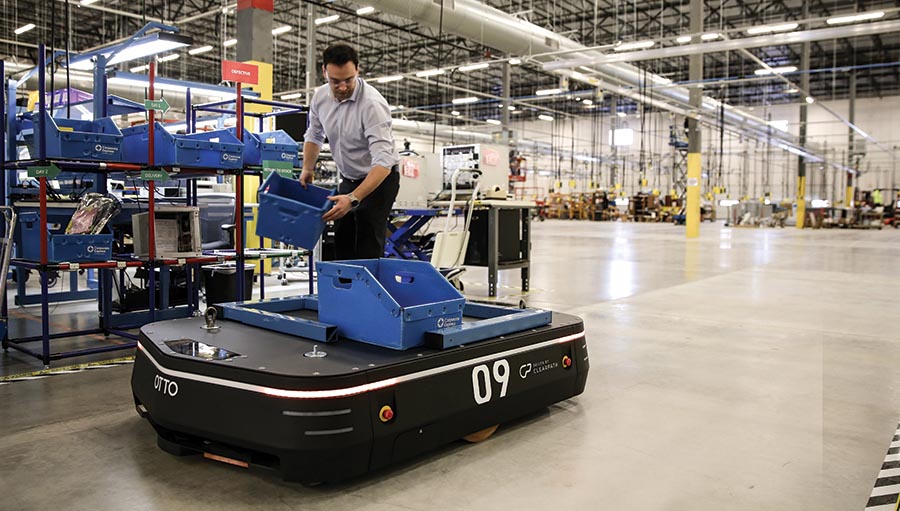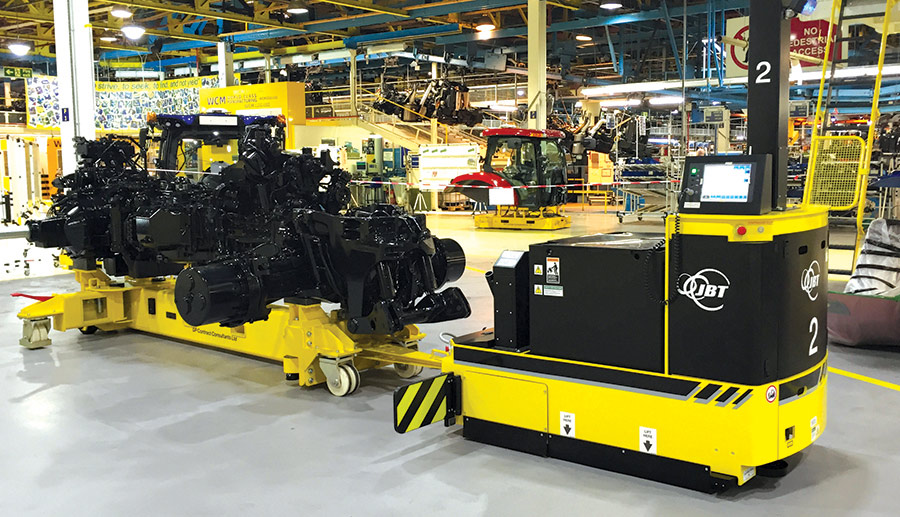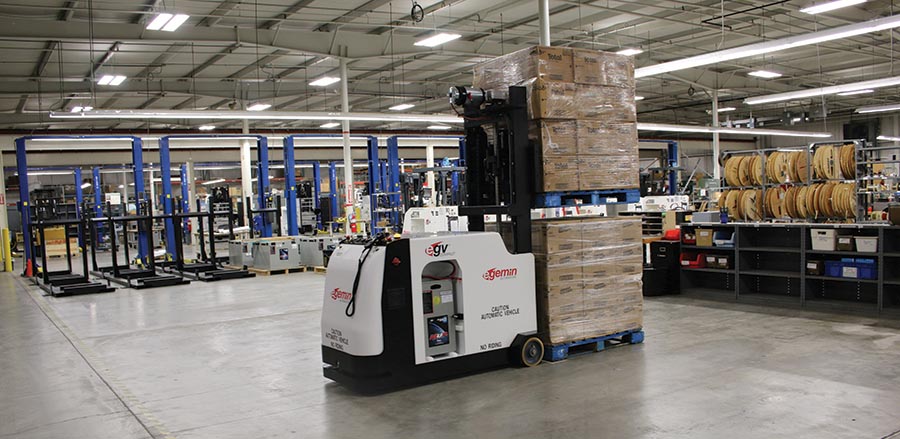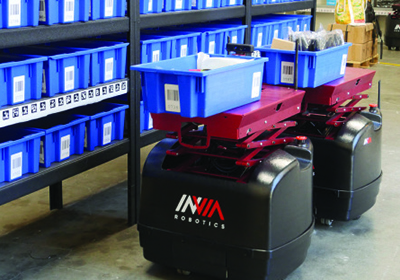As the dream of autonomous cars edges closer to reality, automatic guided vehicles (AGVs) are advancing into the warehouse in a very real way. As the likes of Google and Apple pour resources into the development of driverless technology, the decreased price and improved performance of the vehicles are benefiting the makers of driverless industrial vehicles. Already, Amazon is poised to become one of the biggest users—and suppliers—of automatic guided vehicles in the warehousing and distribution space.
But AGVs aren’t just for those with big budgets and massive operations. In fact, AGVs aren’t even always AGVs. The “guided” part of that acronym, familiar from decades of autonomous vehicles designed to follow magnetic tapes, wires and other fixed paths, is now just one of a growing number of form factors. For the purposes of this story, AGV is an umbrella term including self-driving vehicles, autonomous mobile robots, vision-guided vehicles and more—some of which require no infrastructure to successfully navigate. As these vehicles become increasingly comfortable in dynamic, unstructured environments, these platforms have quickly migrated from manufacturing applications to warehousing supporting manufacturing to pure warehousing and distribution.
“We’re seeing a tremendous amount of interest on both the user and supplier side with lots of new players jumping into this space,” says Jeff Burnstein, president of the Association for Advancing Automation (A3). “We became aware several years ago of a big potential market for AGVs in warehousing, and now it’s really happening. They are opening new opportunities that weren’t even thought of before.”
These vehicles might serve as flexible alternatives to large and expensive conveyor systems, or they might simply take out the trash, but the chances are good that AGVs will become a common sight throughout the supply chain as they target the abundance of non-value-added materials handling.
From there to here
The guidance-dependent AGV tended to be ideal only in large, spacious environments, according to Ed Mullen, vice president of sales for the Americas at Mobile Industrial Robots. With space for dedicated lanes, an AGV was less likely to interrupt—or be interrupted by—any equipment or pedestrians in its area.

“But for a $50 million company with 50,000 square feet, they don’t have room for rails or magnetic strips, and if a forklift jumps in front of an AGV, it has to stop and wait,” Mullen says. “With a collaborative mobile robot, you can tell it to go from the dock to the stockroom, and it will go around people, down different aisles, and adapt in a dynamic environment without slowing production.”
This strength adds flexibility, but it also means opportunities for improvement are sometimes unclear to those unfamiliar with the technology’s potential.
“The biggest challenge is education since companies are still trying to figure out what this is,” Mullen says. “Everybody knows AGVs as used by the Hondas and Toyotas of the world, but few mom and pops have thought about automating materials handling outside conveyance principles. When you really start to think about how product flows—and I use the term loosely to mean both boxes dropped at the dock or garbage collected at the end of the line—you start to see the opportunities.”
Mullen says prospective customers might think of collaborative mobile robots as temporary workers, as compared to the full-time employee model of a conventional AGV.
“When investing in an AGV for a task with a defined start and end point, the return on investment depends on enough work being conducted between those points all year long,” Mullen says. “But with a collaborative mobile robot, you have the entire facility at your disposal. If today you need it to perform a certain task and that changes tomorrow, you can reassign it, the same as a temp worker. A temp is not going to stare at the production line for three days waiting for the next task. You will reallocate him to get additional value.”
Tom Kaminski, CEO of Egemin Automation, says a single AGV might even serve multiple facilities and, unlike a temp worker, can catch a ride from one to another in the back of a truck.
“Our customers are asking for solutions to address seasonality,” he says. “If they are already shipping product, they’ll tuck a vehicle in the same truck to add throughput where it’s needed. They’ll use the AGVs to receive all incoming items in a short window, then move them to the next phase of processing, then to the warehouse and distribution before the cycle starts all over again.”
Even if a vehicle has never before operated in a given facility, as long as it can access a familiar network it’s often possible to program destinations and tasks within an hour, Kaminski says.

For many warehouses, the pressures of labor availability and speedy fulfillment have compelled managers to at least evaluate automated alternatives. However, because of the pace of change in business, few are interested in automation that calls for fixed commitments to process and layouts.
“Warehouse customers are trying to get a solution and get it quick, and they don’t want to design the solution for what might or might not happen five years from now,” says Lior Elazary, CEO of inVia Robotics. “When they are facing peaks of three or 10 times the usual volumes, it’s not easy to change the whole warehouse operation to address that for just one month. With robots, you can add more and more units to increase throughput without restructuring the workflow.”
For example, say a new product launch is expected to generate another 1,000 orders per day. A secondary packing station can avoid a potential bottleneck, Elazary says, and the new destination can be added to the robot’s navigation plans with the click of a button. With a view into traffic at each station, the robot can choose the best option for each delivery.
Software and hard changes
Providing an operational view to each AGV is where increasingly intelligent software comes into play. When integrated with the enterprise resource planning system, the warehouse management system (WMS) or execution software, the AGV becomes the physical extension of the ambitions of the WMS, according to Bill Torrens, sales director for OTTO Motors. However, the “brains” inside each self-driving vehicle interpret real-time conditions to dynamically change its behavior, solving for all the potential variables between the A to B movement that was requested.
Instead of a single, central system trying to make all decisions at the same time, the idea is to make vehicles smart and the higher system relatively simple, like bees in a hive, Torrens says. Because the vehicles know where each other are, they can take a shorter route that might be counterintuitive to a person.
“It’s a philosophical change, but we’re trying to decommission this thick veneer that has built up over time about the movement of materials in bulk,” Torrens says. He explains that the form of materials aligns with the vehicles that move them. For example, you rarely see a lift truck carrying three boxes. “It rubs human beings the wrong way to see equipment with a capacity of 3,000 pounds moving 300. In reality, it might make more sense to the process. Otherwise, you have a forklift take a pallet to forward pick, then take the leftovers back to reserve, when overall it probably made more sense to just take three boxes straight to the dock. It’s more economical to move less more frequently, and robots enable that.”
Throughout its operation, an AGV collects valuable data about the precise time taken to perform the task and any obstacles encountered along the way.
“In many cases, there would otherwise be no way of gathering this data, other than a report at the end of a shift indicating X number of tasks performed,” says Sarah Carlson, vice president of marketing and business development for AutoGuide. “Why did one station perform so few? What other tools could help improve that process? We’re seeing more and more customers whose AGV is their first type of sophisticated automation. It’s interesting how suddenly it almost forces you to become leaner. You have to establish paths, cycle times, destinations, and then customers end up being surprised about the information they get.”
As AGVs become more tightly integrated with broader systems, these benefits multiply. Elazary describes a robotic management system (RMS) capable of managing the robots, certain elements of inventory, and the people working around the robots. Whether fed by a WMS or a simple spreadsheet, the system can facilitate picking, consolidation and delivery of single- or multi-line orders, especially if the AGV is equipped with a manipulator that lets it pick independently of a human.
“For example, consider an e-commerce operation with hundreds of thousands of SKUs. A robot might only be able to pick 50% to 60%, but it can bring a tote of items to a person,” Elazary explains. “It’s a goods-to-person setup that uses existing shelving and totes. The same robot can pick, deliver goods and work alongside human pickers, and the RMS optimizes who does what. It’s all guided and optimized by the customer, and gives them the data they need to make high-level decisions.”
Pathways and portals
Many modern AGV systems make information available through tablets and smart phones. Kaminski even says some vehicle-mounted displays have been removed due to the widespread availability of mobile devices.

“Why include on the vehicle something that everyone already has?” Kaminski asks. “To use an old panel interface is almost a downgrade for today’s tech-savvy managers.”
Instead, a mobile application enables workers to direct or request a vehicle, program new routes and access metrics about the operation. It can also provide information about the condition of the vehicle itself, from temperature to battery state to motor currents. Because in-house or dealer technicians can’t be expected to maintain the various sensors and vision systems on such equipment, AGV manufacturers have gone to great lengths to help their warehousing customers avoid becoming robotics experts.
“In general, the level of technical sophistication in warehouses is less than in manufacturing,” says Mark Longacre, marketing manager for JBT Corp. “You just don’t have the plant engineers and high-level expertise on site at the average warehouse that you would at a large car manufacturer. Therefore, the AGV systems need to be more reliable, user-friendly and easy to diagnose.”
Instead of proprietary systems, most AGV providers have turned to standard, off-the-shelf componentry like motors, encoders, contactors, circuit breakers, cameras and lasers. Built around intuitive interfaces that don’t require an extensive education to program, the software also enables remote monitoring and preventative maintenance to further decrease the burden on users. Taking it one step further, some AGV providers have adopted a “robotics-as-a-service” model that entirely removes the need for users to become equipment owners. A robot can report a fault, take itself out of rotation and trigger the delivery of a replacement unit without customer intervention.
“These are all elements that build on the Internet of Things,” Kaminski says. “This solid, consistent data can tell you exactly what happened, help you identify trends in the system, monitor seasonal and daily production peaks, and see things you would not have witnessed before. The availability and refinement of that data is critical and will help improve functions up and down the supply chain.”
That said, the small operations evaluating automation for the first time will likely start slow. Longacre says one of the greatest benefits of AGVs is the ability to gradually scale, test and transition over time. First is the low-hanging fruit: any materials handling over long distances or repetitive, 24/7 tasks. The second stage, he says, is to introduce the AGV into the warehouse, working with the WMS and performing tasks like loading trailers.
“You slowly add complexity, and at some point we get to step three, where we start monitoring AGVs and forklift traffic with one system manager that controls assignments to all,” Longacre says. “You already see some dual-purpose vehicles that look like forklifts but can be manual or automatic. The industry really needs a dual-vehicle system where both operate in harmony, like collaborative robots, only collaborating with other equipment. The forklift will know where the AGV is, vice versa, and the system can disseminate and manage tasks across the fleet. That’s the future, as all equipment responds properly to all tasks of the day, as well as changes in daily or seasonal peaks.”
About the Author
Follow Robotics 24/7 on Linkedin
About the Author
Follow Robotics 24/7 on Linkedin
Article topics
Email Sign Up
















